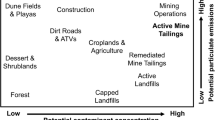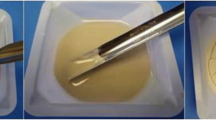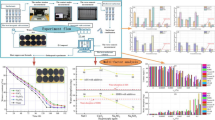Abstract
Handling taconite pellets produces dust. As the pellets are transported, they abrade and produce a fine material that represents a concern for airborne dust. Pellet-breakdown studies revealed that as much as 43% (by weight) of the fine particles were 10 μm in diameter and smaller (material regulated by the U.S. Environmental Protection Agency). This is a significant amount of material that represents a concern for dust emissions; therefore, a dust suppressant is needed. Water is the most common dust suppressant used to prevent fines from becoming airborne. To effectively suppress dust, the material must wet well and must remain wet. Surfactants, hygroscopic materials and binders are additives that address at least one of these concerns. Evaluating the wetting behavior of the iron ore revealed that the pellets were highly hydrophilic (contact angles less than 30°). The wetting kinetics of fine particles were increased 99% using acetyletic glycol surfactants, which demonstrated that these surfactants greatly improved wettability. However, in dust-suppression studies using a drop tower that simulated dust generation in a plant, surfactants did not reduce airborne dust. This indicated that ease of wetting was not the primary problem in suppressing taconite dust. In contrast, hygroscopic materials (that prevent moisture from evaporating) and tall oil pitch (a nonhygroscopic binder) reduced airborne dust by as much as 58%.
Similar content being viewed by others
References
Adamson, A.W., and Gast, A.P., 1997, Physical Chemistry of Surfaces, 4th Edition, John Wiley & Sons Ltd.
ASTM E3, 2001, “Standard guide for preparation of metallographic specimens,” Annual Book of ASTM Standards, Volume 03.01, Metals Test Methods and Analytical Procedures, Metals, Mechanical testing, elevated and low-temperature tests, Metallography, pp. 1–11
Chander, S., Mohal, B.R., and Apian, F.F., 1986, “Wetting characteristics of particles and their significance in dust abatement,” Presented at the International Symposium on Respirable Dust in the Mineral Industries, The Pennsylvania State University, University Park, Pennsylvania, Oct. 14–16.
Cristovici, M.A., 1991, “Investigation to control mine dust using surfactants and a new approach for eliminating their negative effect on flotation,” Minerals & Metallurgical Processing, Vol. 8, No. 1, Feb., pp. 38–42
Draves, C.Z., and Clarkson, R.G., 1931, “A new method for the evaluation of wetting agents,” Proceedings of American Association of Textile Chemist & Colorist, Vol. 20, pp. 109–116.
Griffin, W.C., 1949, “Classification of surface-active agents by ‘HLB’,” Journal of the Society of Cosmetic Chemists, Vol. 1, p. 311.
Jaycock, M.J., and Parfitt, G.D., 1981, Chemistry of Interfaces, Elliss Horwood Ltd.
Jonsson, B., Lindman, B., Homberg, K., and Kronberg, B., 1998, Surfactants and Polymers in Aqueous Solution, John Wiley & Sons Ltd. West Sussex England, pp. 459–461.
Kim, J., 1995, “Respirable Coal Dust Control Using Surfactants—With Special Emphasis On a Liquid Spray System,” Ph.D. Thesis, University of Missouri — Rolla, Rolla, Missouri.
Kobrick, T., 1970, “Water as a Control Method State of the Art Sprays and Wetting Agents,” U.S. Bureau of Mines, Information Circular 8458, pp. 123–131.
Krugliakov, P.M. (Petr Maksimovich), 2000, Hydrophile-Lipophile Balance of Surfactants and Solid Particles: Physicochemical Aspects and Applications, Elsevier Science B.V., Amsterdam, New York.
Mohal, B.R., 1988, “Enhancement of the Wettability of Coal Powders Using Surfactants,” Ph.D. Thesis, The Pennsylvania State University, University Park, Pennsylvania.
Rao, S.R., 2004, Surface Chemistry of Froth Flotation, Revised 2nd Edition, First Edition: L.J. Kluwer, Academic/Plenum Publishers, New York, New York, Vol. 2, pp. 351–384.
U.S. Environmental Protection Agency, 2004, www.epa.gov, Date of Access: Nov. 20, 2004, Search PM10 and PM2.5
Walker, Jr., P.L., Peterson, E.E., and Wright, C.C., 1952, “Surface active agent phenomena in dust abatement,” Ind. and Eng. Chem., Vol. 44, pp. 2389–2393.
Author information
Authors and Affiliations
Rights and permissions
About this article
Cite this article
Copeland, C.R., Kawatra, S.K. Dust suppression in iron ore processing plants. Mining, Metallurgy & Exploration 22, 177–191 (2005). https://doi.org/10.1007/BF03403321
Received:
Accepted:
Published:
Issue Date:
DOI: https://doi.org/10.1007/BF03403321




